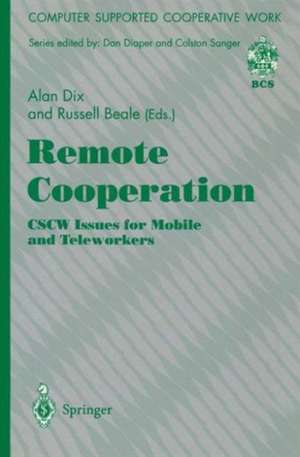Remote Cooperation: CSCW Issues for Mobile and Teleworkers: Computer Supported Cooperative Work
Autor Alan J. Dix, Russell Bealeen Limba Engleză Paperback – 18 oct 1996
Broadly divided into five sections - social and economic context, application domains, software technology and infrastructure, communications technology and infrastructure, working and learning from home - this volume contains contributions from both the research community and industry.
Din seria Computer Supported Cooperative Work
- 20%
 Preț: 1044.25 lei
Preț: 1044.25 lei - 20%
 Preț: 650.59 lei
Preț: 650.59 lei - 20%
 Preț: 647.61 lei
Preț: 647.61 lei - 20%
 Preț: 638.55 lei
Preț: 638.55 lei - 20%
 Preț: 334.53 lei
Preț: 334.53 lei - 20%
 Preț: 328.79 lei
Preț: 328.79 lei - 20%
 Preț: 334.71 lei
Preț: 334.71 lei - 20%
 Preț: 330.90 lei
Preț: 330.90 lei - 20%
 Preț: 328.79 lei
Preț: 328.79 lei - 20%
 Preț: 649.28 lei
Preț: 649.28 lei - 20%
 Preț: 329.91 lei
Preț: 329.91 lei - 15%
 Preț: 642.83 lei
Preț: 642.83 lei - 20%
 Preț: 648.11 lei
Preț: 648.11 lei - 20%
 Preț: 996.40 lei
Preț: 996.40 lei - 20%
 Preț: 647.79 lei
Preț: 647.79 lei - 20%
 Preț: 413.81 lei
Preț: 413.81 lei - 20%
 Preț: 336.02 lei
Preț: 336.02 lei - 20%
 Preț: 346.10 lei
Preț: 346.10 lei - 20%
 Preț: 330.24 lei
Preț: 330.24 lei - 20%
 Preț: 982.36 lei
Preț: 982.36 lei - 20%
 Preț: 329.11 lei
Preț: 329.11 lei - 20%
 Preț: 987.32 lei
Preț: 987.32 lei - 20%
 Preț: 641.34 lei
Preț: 641.34 lei - 20%
 Preț: 648.26 lei
Preț: 648.26 lei - 20%
 Preț: 995.89 lei
Preț: 995.89 lei - 20%
 Preț: 643.63 lei
Preț: 643.63 lei - 20%
 Preț: 988.98 lei
Preț: 988.98 lei - 20%
 Preț: 328.42 lei
Preț: 328.42 lei - 20%
 Preț: 988.81 lei
Preț: 988.81 lei - 20%
 Preț: 643.30 lei
Preț: 643.30 lei - 20%
 Preț: 987.17 lei
Preț: 987.17 lei - 20%
 Preț: 329.58 lei
Preț: 329.58 lei - 20%
 Preț: 309.58 lei
Preț: 309.58 lei - 20%
 Preț: 330.42 lei
Preț: 330.42 lei - 5%
 Preț: 365.82 lei
Preț: 365.82 lei - 20%
 Preț: 650.08 lei
Preț: 650.08 lei - 20%
 Preț: 334.38 lei
Preț: 334.38 lei - 20%
 Preț: 645.79 lei
Preț: 645.79 lei - 20%
 Preț: 650.40 lei
Preț: 650.40 lei - 20%
 Preț: 333.88 lei
Preț: 333.88 lei - 20%
 Preț: 1263.81 lei
Preț: 1263.81 lei - 20%
 Preț: 830.58 lei
Preț: 830.58 lei - 20%
 Preț: 704.70 lei
Preț: 704.70 lei
Preț: 643.50 lei
Preț vechi: 804.37 lei
-20% Nou
Puncte Express: 965
Preț estimativ în valută:
123.14€ • 131.67$ • 102.67£
123.14€ • 131.67$ • 102.67£
Carte tipărită la comandă
Livrare economică 17 aprilie-01 mai
Preluare comenzi: 021 569.72.76
Specificații
ISBN-13: 9783540760351
ISBN-10: 3540760350
Pagini: 256
Ilustrații: XV, 236 p. 30 illus.
Dimensiuni: 155 x 235 x 13 mm
Greutate: 0.36 kg
Ediția:1st Edition.
Editura: SPRINGER LONDON
Colecția Springer
Seria Computer Supported Cooperative Work
Locul publicării:London, United Kingdom
ISBN-10: 3540760350
Pagini: 256
Ilustrații: XV, 236 p. 30 illus.
Dimensiuni: 155 x 235 x 13 mm
Greutate: 0.36 kg
Ediția:1st Edition.
Editura: SPRINGER LONDON
Colecția Springer
Seria Computer Supported Cooperative Work
Locul publicării:London, United Kingdom
Public țintă
ResearchCuprins
So Near Yet So Far.- The Structure of this Book.- Framing the Problem.- Future Directions and Further Information.- 1 Working in the Virtual Office.- 1.1 Introduction.- 1.2 Why Are People Working in Virtual Offices?.- 1.3 Technology for the Virtual Office.- 1.4 Advantages of Working in a Virtual Office.- 1.5 Disadvantages of Working in a Virtual Office.- 1.6 Addressing the Disadvantages of the Virtual Office.- 2 CSCW for the Mobile Teleworker.- 2.1 Introduction.- 2.2 How Telework Concepts Affect Field Based Mobile Workers.- 2.3 How Telework Concepts Affect Intrinsically Mobile Workers.- 2.4 The Basic Technology for Mobile Telework.- 2.5 The Role of CSCW.- 2.6 The Basic Technology of CSCW for Mobile Workers.- 2.7 The Interaction Between CSCW and Telework.- 2.8 Teamworking Across Enterprise Boundaries.- 3 The Electronic Hard Hat: CSCW on the Construction Site.- 3.1 Introduction.- 3.2 Review of Past Work.- 3.3 Available Technology.- 3.4 CSCW on the Construction Site: a Possible Scenario.- 3.5 The Electronic Hard Hat.- 3.6 Future Scenarios.- 3.7 Conclusion: A Plea to Communications Companies.- 4 Support for Community Care.- 4.1 Introduction.- 4.2 Community Health Services and Community Care Workers.- 4.3 Community Care Systems.- 4.4 The Field Trial of System B.- 4.5 Some Results of the Evaluation Exercise.- 4.6 Comparison with System A.- 4.7 Conclusion.- 5 The’ salesman’s Promise’: CSCW in Sales.- 5.1 Introduction.- 5.2 The Cell Based Factory.- 5.3 Sales Scenarios.- 5.4 Product Advisor.- 5.5 Conclusions.- 6 Observations on Practically Perfect CSCW.- 6.1 Introduction.- 6.2 General Requirements.- 6.3 Toward Observational Properties.- 6.4 Using the Model.- 6.5 Toward Practically Perfect CSCW.- 6.6 Conclusions.- Acknowledgements.- 7 Personal Information Management in theContext of Collaborative Work.- 7.1 Introduction.- 7.2 Personal Information Management and the Representational Focus.- 7.3 Time Management: A Case for CSCW?.- 7.4 Personal Information Management and CSCW.- 8 Activity Coordination in Decentralized Working Environments.- 8.1 Introduction.- 8.2 Some Aspects of Activity Coordination.- 8.3 The Task Manager: An Example for Activity Coordination.- 8.4 Consistency in an Asynchronous Environment.- 8.5 Conflict Handling.- 8.6 Mobility and Activity Coordination.- 8.7 Summary.- 8.8 Outlook.- 9 Information Requirements of Distributed Workers.- 9.1 Introduction.- 9.2 Background — The Workers and the Technology.- 9.3 Principal Topics.- 9.4 Retrieval and Caching.- 9.5 Synchronization.- 9.6 Other Areas and Future Work.- 9.7 Summary.- 10 Mobile Open Systems Technology for the Utilities Industries.- 10.1 Introduction.- 10.2 Requirements of Mobile Utilities Workers.- 10.3 Integration Technologies.- 10.4 Mobile Computing Technologies.- 10.5 The Impact of Mobility on Distributed Systems Platforms.- 10.6 The MOST Approach.- 10.7 Concluding Remarks.- 11 The Distributed Home Environment and the New Oikos.- 11.1 Introduction.- 11.2 The Oikos Concept.- 11.3 The Distributed Home and Telework.- 11.4 The Homelink Project.- 11.5 Future Directions.- 11.6 Summary.- 12 Teaching, Learning and Collaborating at a Virtual Summer School.- 12.1 Introduction.- 12.2 Design Issues.- 12.3 Teaching and Learning at a VSS.- 12.4 Evaluation and Discussion.- 12.5 Discussion and Conclusions.- Appendix: A Detailed Profile of the VSS Students.- References.- Name Index.
























